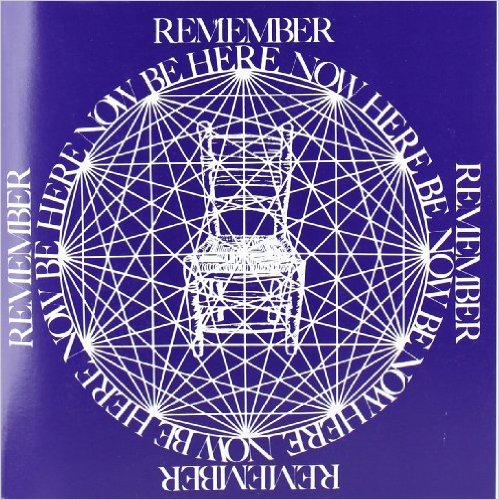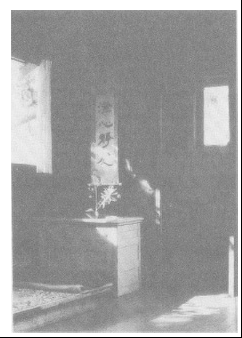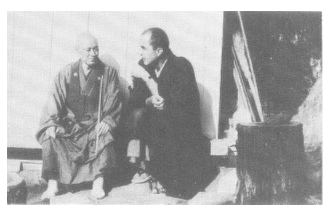Ram Dass
Ram Dass (born Richard Alpert; April 6, 1931 – December 22, 2019)
Ram Dass dot org
Tricycle Obituary
Article on Ram Dass
Wikipedia page for Ram Dass
 David
Padwa has some great photos with Ram Dass and him and others - Here's
one from 1988
David
Padwa has some great photos with Ram Dass and him and others - Here's
one from 1988
Ram Dass talks about David Padwa in
a 1980 Albuquerque Sun interview.
The Psychedelic Experience by Leary, Alpert, and Metzner gave me their take on the Tibetan Book of the Dead. That book I digested thoroughly and used as a guide with a human guide for the first LSD trips I had and it was most helpful. That mixed with past influences definitely got me motivated to find a teacher and community to meditate with.
I'd hear what was happening with Richard Alpert from people who were in or around the Zen Center from the time that I arrived. My sister and I went to hear a talk he gave. I remember him at the Human Be-in in 1969 sitting up on the stage with Timothy Leary, Gary Snyder, and Allen Ginsberg and Shunryu Suzuki up there with them for a while. I recall talking to him in front of Richard Baker's place soon after Baker became abbot. He was fresh back from India. Maybe Bagavandas was there then too or maybe that was later. The last time I saw him was at an event for Zig Zag Zen held at Spirit Rock. We were both contributors to that book. It was after his 1997 stroke and his speech was halting, but he kept up. - DC
Will be making a few additions to this page just going up the first hour of December 25th, 2019.
Steve Tipton let me know about Ram Dass' passing a couple of days ago. In his
email he wrote:
Dick and I were
housemates for a while in late 1976 at Mirabai’s, next door to David and Mary
McClelland’s manse on Washington St in Cambridge, Mass. He read a draft of
Getting Saved from the Sixties, and said, “If you can do this, you’re
wasting your time. You should live it, not write about it.” That was his job,
not mine, I said, and we both had half a laugh. - Steve Tipton
 BE HERE NOW
BE HERE NOW
I remember when Be Here Now first came out and we got some copies at Tassajara.
It came from Lama Institute where Jonathan Altman had been involved before he
came to Tassajara and was printed on rough brown paper and was super trippy and
cool. It had a section on Tassajara and something I just noticed, didn't mention
Shunyru Suzuki, though it had a photo of him and Richard Baker outside a cabin
at Tassajara.
***
Be Here Now led me to Tassajara after reading the schedule printed in the book. I was graduating from high school in central New York state. I had no idea that I would actually go to Tassajara. I don't mean that I set down the book and decided to go. It just turned out that way. Years later I was able to hug him when he gave a talk at Spirit Rock. I still have my original copy of Be Here Now. It sits out on a mantle to continue to inspire. - Ted Howell
***
My intent had always been to get to Tassajara Springs. I learned about it from the Ram Dass book, Be Here Now, calling Tassajara Springs the next day on the camp radiophone. Inside a week, with four months pay in my pocket, I was flown out of the logging camp on the West Coast of Vancouver Island in a three-seat propeller plane to Vancouver, where I took a Greyhound bus to California. - Leland Smithson
***
from David M. Bader's Zen Judaism: For You, a. Little Enlightenment. -- Be here now. Be someplace else later. - sent in by Gil Friend
***
Excerpt from Be Here Now (1971) about Tassajara.
Perhaps the most appropriate initial step in view of your present predicament is to continue with your daily life in the customary manner with the simple addition of a mantra. Such a mantra can initially be used for 15 minutes in the morning and evening as suggested by Maharishi Mahesh in his program for Transcendental Meditation. You can set up a corner of your room for this purpose. Create a quiet corner in your home . . . an Om Home . . . a launching pad to the infinite . . . a meditation seat . . . a shrine. Bring to it that which is simple and pure: a mat, perhaps a candle, maybe a picture of a realized being whose life has turned you on—Buddha, or Christ, or Ramakrishna, or Ramana Maharshi, possibly some incense. Create a seat in which you can sit comfortably with spine straight out and turn off your body. Those who have developed the triangular seat of padmasa (full lotus), siddhasa (half lotus), or even sukhasa (the easy pose) . . . remember, no suffering. In this corner establish a regular ritual for purification, for reflection, for calming the mind. Just as water wears away stone, so daily sadhana will thin the veil of avidya (ignorance). At quite the opposite end of the continuum is the total moment-to-moment discipline of each thought and act required in a monastery or ashram. Here is but one example, presently functioning in the United States. It is Tassajara, a Zen Buddhist center in California.

A student cabin at Tassajara
The Zen Center
See the original scan - thanks Ted Howell
Bell ringing at 4 a.m. You get up immediately. Han (block of hard ash wood struck with wooden mallet) starts at 4:05. 15 minute han, 3 rounds. You should be in the zendo by end of second round. Zazen (sitting meditation) starts at 4:20. 40 minute period. Roshi makes a round of the zendo in the beginning. People bowing as he approaches (actually, gassho-ing—hands together and bow). Bell sounds after 40 minutes. Kinhin (walking meditation) begins. Kinhin for 15 minutes. (Hands on chest, walking very slowly in a line, about a half step with each breath). Second period of zazen (40 minutes). Service at 5:50. Consists of bowing to the floor 9 times, reciting the Heart Sutra 3 times, bowing to floor 3 times; lasts about 20 minutes. With bells and large wooden drum. Study period. One hour. In large room with fire if it’s cold. Kerosene lamps. Tea is served. Warmth often makes you drowsy. You read various texts. Short chant at beginning and end of period. Han for breakfast starts at 7:10.
Breakfast is served in the zendo. You sit on cushions in meditation posture. Each student has: an oryoki (set of 3 bowls, spoon and chopsticks, a scraper, setsu (stick with cloth end), and 3 cloths (for napkin, bowl-wiping, and cloth in which entire oryoki is wrapped—folded and tied in prescribed manner). Ritual way for untying and removing bowls. Bowls are placed on an eating board in front of each student. Complicated oryoki ritual helps to focus attention. Meals are a sort of meditation, in silence, with as little noise as possible. Chanting precedes meal (in English at breakfast, Japanese at lunch). After short chant, students set up their oryokis. Chanting resumes and servers enter. As server stops before student, they bow to each other, server kneels and dishes food into bowl, they bow again and server goes on to next student. There is chanting while food is served (reciting names of Buddha and Bodhisattvas). When servers leave there is more chanting (we should be mindful of where this food comes from and whether our practice deserved it). Meal is eaten. When meal is finished server enters with hot water and there is a short chant. Hot water is poured in large bowl. Bowl is cleaned and water poured in second bowl, bowl wiped with cloth, and so on until the bowls are cleaned. Water is drunk, with a little bit saved and collected at the end (it’s taken out and poured on a plant). Oryokis are tied up and put away (placed by the side of each student). Clackers and bow at the end of meal, roshi and priests leave, then students leave. As students file out of zendo they exchange bows with the cook.
Short period (about 20 minutes) in which you change into work clothes, take care of toilet, etc. Work drum sounds at 8:40. Students assemble for work meeting. Short informal meeting to make sure each student knows what he’s doing, has some task assigned to him, and jobs are co-ordinated. Work period until han 11:10. Gardening, carpentry, masonry, roofing, garbage collecting, cleaning, sewing, etc. Han at 11:10. 20 minutes to clean up, change into robes and get to zendo. (There is a 15 minute han for this, so one can gauge his time.) Zazen (40 minutes). Service (bowing and reciting Heart Sutra). Lunch (same procedure as breakfast). Usually soup, bread, and vegetable. After lunch there is a rest period, about 30–40 minutes. (This is the chance to get some sun.) Work drum sounds at 2 (or 2:05). After short work meeting you return to your job. At 3:30 a bell signals tea. Everyone gathers on steps in front of zendo (where there is still some sun), a short chant and tea is served. Sometimes there is a treat (crackers, cookies). A short chant at the end and people return to work. At 5 p.m. drum signals end of work. Clean up, put away tools, tidy work area. Bath time. Everyone heads for the hot sulphur baths. Before entering bath student bows before altar and recites gatha (verse). Silence in bath. (It is already dark in the winter, and quite cold. Kerosene lamp, cement grotto, steam rising from water, shadowy forms. Bath, at about 110˚ is the one chance for the body—feeling all day like a piece of cold iron—to get really warm. Blood returns to body.) Students bow and recite gatha before leaving. Bell begins at 5:35. 15 minutes to service. Evening service (as before). Supper. No chanting, simply clackers before and after meal. Brown rice, miso soup, and vegetable. After supper there is free time. You return to your cabin or go to the large room where there is a fire. Han starts at 7:30. Study period (at 7:45) when there is no lecture. Lecture—by roshi, priest, or student—is in zendo, at 8. Zazen (at 8:35, lecture may extend into this period). Ends with slow deep chanting of Heart Sutra. Students return to cabins. Lights out at 9:30. There is a day off on 4 and 9 days (for example, the 4th, 9th, 14th . . .). This begins after breakfast. On 4 days (officially only 1/2 day off) there is a general discussion in the morning attended by all; completely open—gripes, questions, views, personal problems; feedback for those directing Tassajara; very helpful for students to know where other students are, what sort of problems they’re facing. On days off, students are expected to take care of personal needs—laundry, mending, shaving head, and so forth. The Fall Practice period is 2 months; the Winter (or Spring) Practice period is 3 months. Each period ends with a 7 day sesshin—periods of intense meditation—17 hours a day of zazen and kinhin, including meals, lecture, bath, and short work period.

Shunryu Suzuki and Richard Baker at Tassajara - 1967
Dass, Ram. Be Here Now (Enhanced Edition) (pp. 99-103). On Amazon.
As an Amazon Associate Cuke Archives earns from qualifying purchases.